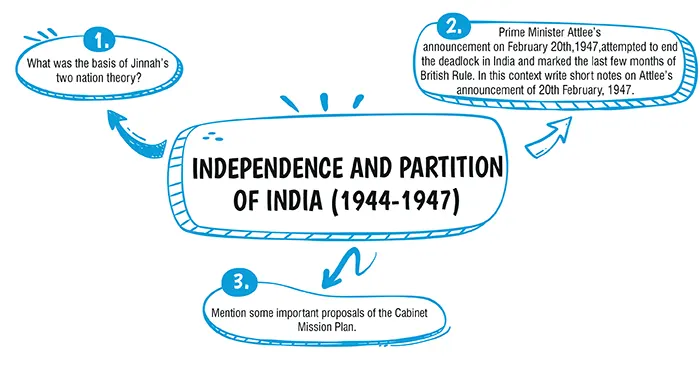Home / Board / ICSE / important Questions / Class 10 / History & Civics / Independence and Partition of India (1944-1947)
Table of Contents

Ans. (c) the proposed federal government was to have very little power, hence would fail
Explanation:
The Congress declined the Viceroy's offer to establish an Interim Government due to its perceived limitations in terms of authority and because it did not accept the principle of parity with the Muslim League. Additionally, Congress objected to the League's assertion that it had exclusive rights to nominate all Muslim members to the Executive Council.
Ans. (d) Sardar Vallabhbhai Patel
Explanation:
Vallabhbhai Patel, serving as the Minister for Home and States Affairs, undertook the crucial task of uniting the British Indian provinces and the princely states into a cohesive and unified India.
Explanation:
Jinnah in his Presidential address at Lahore session declared that Hindus and Muslims belong to two different civilizations which are based mainly on conflicting ideas and conceptions. If these two communities live in one nation, it will be disastrous.
Explanation:
The Congress and the Muslim League could not work together for long. The Muslim League went on harping on its demand for division of India. Jinnah said, ‘We shall resist anything that militates against the Pakistan demand’. The British Government, who watched the situation with utmost vigilance, was then compelled to change its policy of saving India from its division into two. The Prime Minister of England, Mr. Clement Attlee, announced on 20th February, 1947.
(i) Britain would withdraw from India and transfer power to responsible Indians by June 1948.
(ii) If no agreement was arrived at, Britain would still withdraw and hand over power to one or more than one Government.
(iii) Lord Mountbatten was to replace Lord Wavell as the new Viceroy of India.
Explanation:
Clauses of the Cabinet Mission Plan :
(i) Federal Union : There was to be a federal union of the British Provinces and the Princely States. The Union Government (Central Government) should deal with the following subjects: Foreign Affairs, Defence and Communication.
(ii) A Constitution making Body : A Constituent Assembly would frame the Union Constitution. It was to consist of 389 members out of which the provinces were to elect 296 members, whereas Princely States were allocated 93 seats.
(iii) Provincial Autonomy : The Provinces would enjoy full autonomy for all subjects other than the Union Subjects.
(iv) Grouping of Provinces : The British Provinces would be divided into three groups namely ‘Group A’, ‘Group B‘, ‘Group C‘. Each group could determine the provincial subjects to be taken in common.
Download Mind Map of this chapter
Download NowWant to Practice Mock Tests of this chapter
Practice NowDownload Important Questions of this chapter
Download NowCBSE Important Questions Class 10
ICSE Important Questions Class 10
CBSE Important Questions Class 10
ICSE Important Questions Class 10